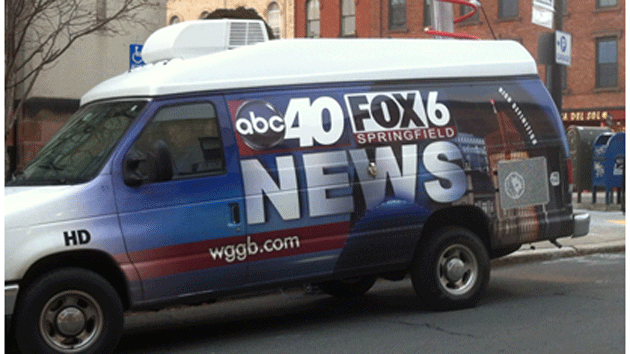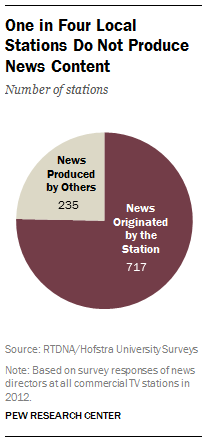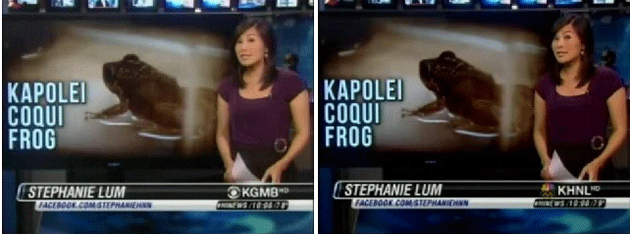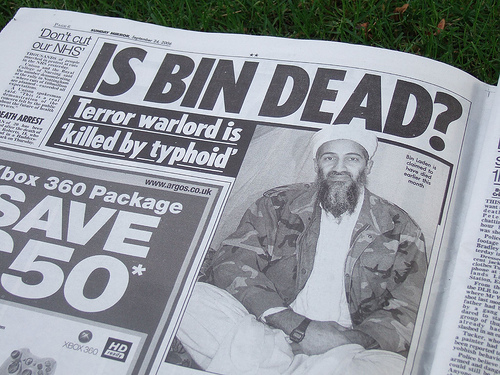
A news truck shared by two local television stations.<a href="http://www.journalism.org/2014/03/26/a-boom-in-acquisitions-and-content-sharing-shapes-local-tv-news-in-2013/pj-2014-sotm-acquisitions-content-sharing-06/">Deborah Potter</a>/Pew Research Center
Everybody knows that most local TV newscasts kind of suck. On television, if it bleeds it leads, and if it’s cheesy and trite it wins the night. Local news is a reliable source for late-night comedians—and The Simpsons has been lampooning it forever. Yet despite all of the genre’s shortcomings, local TV news still manages to reach 9 in 10 American adults, 46 percent of whom watch it “often.” It may come as a surprise to you internet junkies, but broadcast television still serves as Americans’ main source of news and information. Which is why it matters that hundreds of local TV news stations have been swept up in a massive new wave of media consolidation: It means that you, the viewer, are being fed an even more repetitive diet of dreck.

In terms of dollar value, more than 75 percent of the nearly 300 full-power local TV stations purchased last year were acquired by just three media giants. The largest, Sinclair Broadcasting, will reach almost 40 percent of the population if its latest purchases are approved by federal regulators. Sinclair’s CEO has said he wants to keep snapping up stations until the company’s market saturation hits 90 percent. (And that’s not a typo.)
Now here’s where things really get sketchy: Media conglomerates such as Sinclair have bought up multiple news stations in the same regions—in nearly half of America’s 210 television markets, one company owns or manages at least two local stations, and a lot of these stations now run very similar or even completely identical newscasts, according to a new report from the Pew Research Center. One in four local stations relies entirely on shared content. (See chart at right.)
On Monday, the Federal Communications Commission finally took steps to curb the practice. The commission’s rules have long prohibited companies from owning more than one of the four top-rated stations in a given market. But there was no rule preventing a single company from managing more than one station per market. Companies exploited this loophole by controlling stations through “joint sales agreements”—essentially shell companies formed just to hold the broadcast license. “Removal of the loophole helps ensure competition, localism, and diversity in local broadcast markets by preventing a practice that previously resulted in consolidation in excess of what is permitted under the Commission’s rules,” the FCC said in a press release.
You can bet on plenty of pushback from the industry. (More on that below.) As it stands, some local stations simply share office space or vans or helicopters, but others take the overlap much further. To offer one example, CBS and NBC affiliates in Syracuse, New York, use separate anchor teams but run nearly identical stories produced by a shared group of reporters. In some markets, partner stations run virtually identical newscasts, albeit at different times. And then there are stations like the CBS and NBC affiliates in Honolulu, which don’t even bother staggering the times: They run identical newscasts simultaneously.

The media conglomerates also share plenty of local content between markets, which is why you’ll see a story on your local station about some awful crime you didn’t need to know about that took place far away—or some schmaltzy puff piece. Conan O’Brien has had much fun with this sort of thing:
Proponents of the joint sales arrangements argue that they enable small-market stations to cobble together better newscasts than they could afford to deliver on their own. Yet media watchdogs say it’s all just a scheme to line the pockets of big station owners at the expense of viewers. “You have these viewing choices across local stations, but you don’t really have alternatives if they are presenting the same thing,” media researcher Danilo Yanich of the University of Delaware told Pew. “That’s what’s wrong with it.”
The top conglomerates are certainly raking it in: The stock value of Nexstar Broadcasting Group, which owns or services dual stations in 37 of its 56 markets, more than tripled last year. The value of Sinclair’s stock more than doubled. Gannett’s stock price jumped 34 percent the day that it announced that it was spending $2.2 billion to buy 17 TV news stations owned by Dallas-based Belo Corp. In addition to shaving operating costs, consolidation enables the increasingly powerful owners to negotiate much higher retransmission fees from cable providers.
Monday’s FCC ruling is far from the last word on the matter. Media conglomerates can apply for waivers if “strict compliance with the rule is inconsistent with the public interest.” (Historically, corporate media lawyers have been pretty adept at arguing that what’s in the industry’s interest is also in the public interest.) And the FCC hasn’t cracked down on the overall size of local TV news conglomerates or regulated “shared service agreements,” which allow stations with different owners to pool resources—including reporting teams.
Craig Aaron, CEO of the media watchdog group Free Press, nevertheless views Monday’s ruling as an indication that FCC Chairman Tom Wheeler, who was appointed late last year, will do more than his predecessors to stand up to Big Media. The vote signals that “Wheeler is willing to break with the past,” Aaron said in a statement. “It’s time for conglomerates to start playing by the rules.”
















